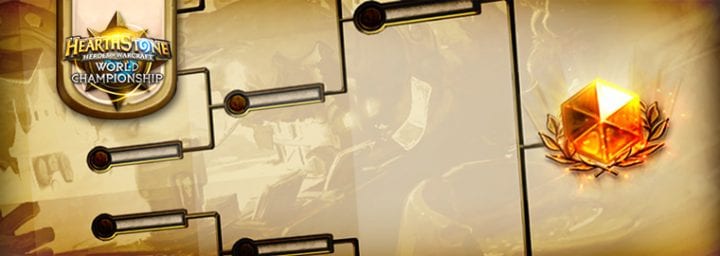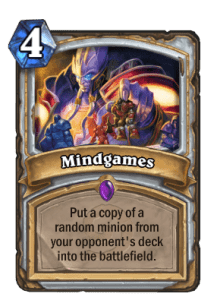
Hearthstone e-Sports Series #3: Tournament Format, Part 2
by JR Cook - 9 years ago show comments
Hearthstone is a pretty fun game by itself, just the numbers and cool abilities, different heroes, and the ever changing metagame. Even if some might regard to it as “casual”, Hearthstone has enough meat to it to keep an avid theorycrafter busy for days. But ever since Blizzcon, I’ve become pretty interested with other side of Hearthstone, and that’s its E-Sport potential. I’ve spent plenty of hours not only watching and enjoying, but also analyzing every aspect of Hearthstone’s E-Sport aspect.
Last week we started talking about Tournament Formats, specially the existing ones. This week we will turn around and introduce a few Tournament Format Concepts of our own, stick around to see how this two wild ideas could change the way we look at Hearthstone eSports.
The Double Duel Format
Deck match-ups can be a real issue on Hearthstone. Regardless of how you build your line-up, the first match is usually a blind pick between 3 or more decks and there’s a pretty big random factor involved when it comes to who’s going to get the match-up advantage. Even in the Conquest format where the winner can’t pick the same deck again, the ability to predict what your opponent is going to play next is heavily compounded by luck.
One way to completely fix the match up problem is rather trivial, you have every deck face each other. The problem with this approach is obviously that if you have 3 decks a piece then you have 9 unique match-ups, and of course a best of 9 would take forever. But what if players had only 2 decks instead? Like Brian “BMKibler” Kibler of BMKGaming, said to start of the year over at BMKGaming.com (that stands for Brian McCormick Kibler Gaming btw) there’s a lot of merits to trying out single-deck formats. Two decks would be a nice compromise between single-deck and the usual formats that have each player bring 3+ decks and been the norm with Hearthstone eSports.
So how would this work? Well each player brings 2 different class decks which means that there are 4 possible unique match-ups. The order of the match-ups isn’t that important as you gotta go through all of them anyways. Perhaps you want the best match up first so you can win easily and try to hide as much information from your opponent, or perhaps you want to try and win the worst match-up to put pressure on your opponent. You could choose the match-ups randomly or have the players decide what they want to play first and second, still if the match is 2-2 after four then you move into a blind pick tie-breaker.
The Blind Pick is then very important, and since both players have two games worth of information for each of the decks your opponent is bringing, you could make an informed choice. Imagine the mind games!
By reducing the number of decks that a player brings and forcing players to go through all possible match-ups, there’s more emphasis on deck building and the ability of a player to prepare for the tournament meta.
The Dual Spec Format
But what about a pure single-deck format? When playing just one deck, the match-up problem rotates from queuing the right decks into facing the right opponents. While the Bracket Format usually brings a way to avoid being knocked out due to facing a poor match-up early in the form of Double Elimination or Swiss Rounds, but that is usually not deemed enough for card games. Instead, most single-deck formats use something called the sideboard.
A sideboard is a set of cards in a collectible card game that are separate from a player’s primary deck. It is used to customize a match strategy against an opponent by enabling a player to change the composition of the playing deck. The Sideboard is usually there to make a bad match-up more palatable and it usually consists of what you would call tech cards.
The problem is that the Hearthstone Game Client doesn’t really support sideboarding. You would have to go into the collection and manually edit your deck for every match. You see how that would be clunky and would lend itself to mistakes or downright cheating by adding cards that are not on the sideboard.
So in order to bypass this issue we will tap into World of Warcraft mechanics. Dual Talent Specialization (or dual spec) is a skill players at level 30 can learn from their class trainers. Introduced in patch 3.1.0, dual talent specialization is the ability to switch between two specializations, talent sets, glyph sets, and action bars. More importantly, some of each class spells were unique to each specialization, while others remained core to the class.
That is what gives this format its name, in the Dual Spec Format you choose a Single Class and build 2 lists for it. Each list has to be composed of 25 Core Cards which must be the same on both versions of the deck, each list is rounded-up by 5 Specialization Cards which make the difference between both versions of your deck. The Amount of Core and Specialization cards could also be tweaked for additional balance, should it be needed.
Since there’s not much sense with having the same match-up 5 times on a row, this format allows you to from Best of Five Series (B05), and instead go into Best of Three (B03). With Bo3 series between the same match-up, you would also reduce the chance of bad draws dictating how a particular match-up goes and viewers would get to experience a more truthful version of each actual match-up instead of just having a taste of it with one match. You would also get a bigger sample size to see how your favorite player plays his deck of choice when the stakes are up high. Finally, this would also make each series considerably faster, which opens the possibility to see more Round Robin Groups. By having each player face all of the opponents on his group, the match-up problem moves from sheer luck into deck-building skill as those players who can anticipate the tournament meta will be heavily rewarded.
On the usual formats a size 4 group qualifier consists of 5 series for a maximum of 25 matches. a 4 Player Round Robin group qualifier is just 6 series for a maximum of 18 matches. You could even go out of the box and have BO1 for the qualifiers. An 8 player B01 Round Robin qualifier is only 32 matches, compared to the Max 50 of having two size 4 groups with the usual Bo5 group format. Still, rotating up the players that fast might be an issue production wise, and the time overhead from the players getting set up might negate any time advantage from going Bo1.
Moving Forward
So there’s my two main ideas to spice up Hearthstone eSports, what do you think about them? Do you have any format proposals of your own? Let me know using the comment section below or catch me on twitter @DannieRay23.
That’s it for this week, but join us next week as we will take a hard look into the game itself, its mechanics, and how do they affect the eSport scene.
In case you missed the first few entries of the series, you can check them out here.



We really NEED single deck formats.